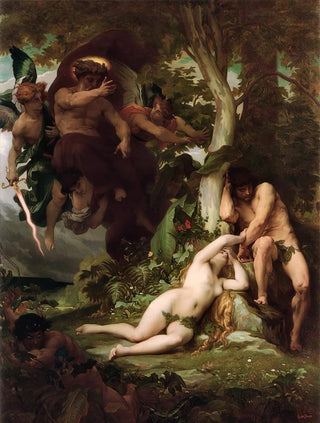Painting L'expulsion d'Adam et Ève du jardin du paradis - Alexandre Cabanel | Art print


View from behind

Frame (optional)
Alexandre Cabanel’s “The Expulsion of Adam and Eve from the Garden of Paradise” is a masterpiece of the 19th century, embodying both the richness of Christian mythology and the artistic expression of the academic movement. This canvas, depicting the tragic moment when Adam and Eve are cast out of Eden, evokes powerful emotions and invites deep reflection on the human condition. The scene, laden with symbolism, captivates the viewer through the beauty of the figures and the finesse of the details, encouraging contemplation on themes of disobedience, loss, and redemption. The art print of this iconic work allows you to immerse yourself in a rich and evocative visual narrative that still resonates today.
Style and uniqueness of the work
Cabanel, an undisputed master of Romanticism, stands out for his academic style and his ability to fuse realism with a touch of sensuality. In "The Expulsion of Adam and Eve from the Garden of Paradise," he succeeds in capturing not only the physical beauty of the protagonists but also the emotional intensity of their situation. The bodies of Adam and Eve, sculpted with remarkable precision, are bathed in a gentle light that emphasizes their expressions of despair and sadness. The contrast between the lush greenery of the garden and the aridity of the outside world symbolizes the passage from innocence to knowledge, a duality that Cabanel explores with rare skill. The delicate drapery of the clothing and the meticulous details of the faces demonstrate technical mastery that elevates this work to the rank of great masterpieces in art history.
The artist and his influence
Alexandre Cabanel, born in 1823, is one of the most influential artists of his time. Trained at the École des Beaux-Arts in Paris, he quickly gained fame through his portraits and historical works. His artistic vision, rooted in Romanticism, managed to establish itself amidst emerging currents of Realism and Impressionism. Cabanel also played a role

Matte finish

View from behind

Frame (optional)
Alexandre Cabanel’s “The Expulsion of Adam and Eve from the Garden of Paradise” is a masterpiece of the 19th century, embodying both the richness of Christian mythology and the artistic expression of the academic movement. This canvas, depicting the tragic moment when Adam and Eve are cast out of Eden, evokes powerful emotions and invites deep reflection on the human condition. The scene, laden with symbolism, captivates the viewer through the beauty of the figures and the finesse of the details, encouraging contemplation on themes of disobedience, loss, and redemption. The art print of this iconic work allows you to immerse yourself in a rich and evocative visual narrative that still resonates today.
Style and uniqueness of the work
Cabanel, an undisputed master of Romanticism, stands out for his academic style and his ability to fuse realism with a touch of sensuality. In "The Expulsion of Adam and Eve from the Garden of Paradise," he succeeds in capturing not only the physical beauty of the protagonists but also the emotional intensity of their situation. The bodies of Adam and Eve, sculpted with remarkable precision, are bathed in a gentle light that emphasizes their expressions of despair and sadness. The contrast between the lush greenery of the garden and the aridity of the outside world symbolizes the passage from innocence to knowledge, a duality that Cabanel explores with rare skill. The delicate drapery of the clothing and the meticulous details of the faces demonstrate technical mastery that elevates this work to the rank of great masterpieces in art history.
The artist and his influence
Alexandre Cabanel, born in 1823, is one of the most influential artists of his time. Trained at the École des Beaux-Arts in Paris, he quickly gained fame through his portraits and historical works. His artistic vision, rooted in Romanticism, managed to establish itself amidst emerging currents of Realism and Impressionism. Cabanel also played a role
12,34 €






